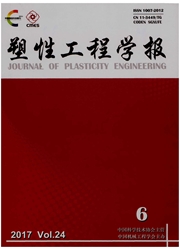

 中文摘要:
中文摘要:
提出面向金属体积成形过程的自适应耦合无网格-有限元法,阐述了实现自适应耦合的具体算法,及有限元区域与无网格区域的双向动态转换。在数值计算过程中,对发生畸变的有限元区域,将其转换为无网格区域;对已经脱离主变形区的无网格区域,将其转换为有限元区域。该方法保证了只在需要的地方实施无网格法,既能避免有限元法带来的网格重划分,又能有效克服纯无网格法计算效率低下的缺陷,充分发挥耦合方法的优势。采用自适应耦合方法对轴对称复合挤压过程进行数值模拟,与有限元法计算结果对比,验证了该方法的正确性和有效性。
 英文摘要:
英文摘要:
An adaptive EFG-FE coupling method is proposed for bulk metal forming processes. The algorithms to implement adaptive coupling are elaborated. The bidirectional conversion between FE regions and EFG regions is enabled. In the numerical analysis, severely deformed FE regions are converted to EFG regions, while the EFG regions outside the main deformation zone are converted to FE regions. The meshless modeling is limited to the areas where it is needed. Remeshing procedures are no longer required as in the conventional FEM, and the computational inefficiency of the full meshless method is relieved. The proposed adaptive coupling method is applied to the numerical simulation of axisymmetric forward-backward extrusion. It is shown that this method is reasonably accurate and valid compared with the FEM results.
 同期刊论文项目
同期刊论文项目
 同项目期刊论文
同项目期刊论文
 期刊信息
期刊信息
